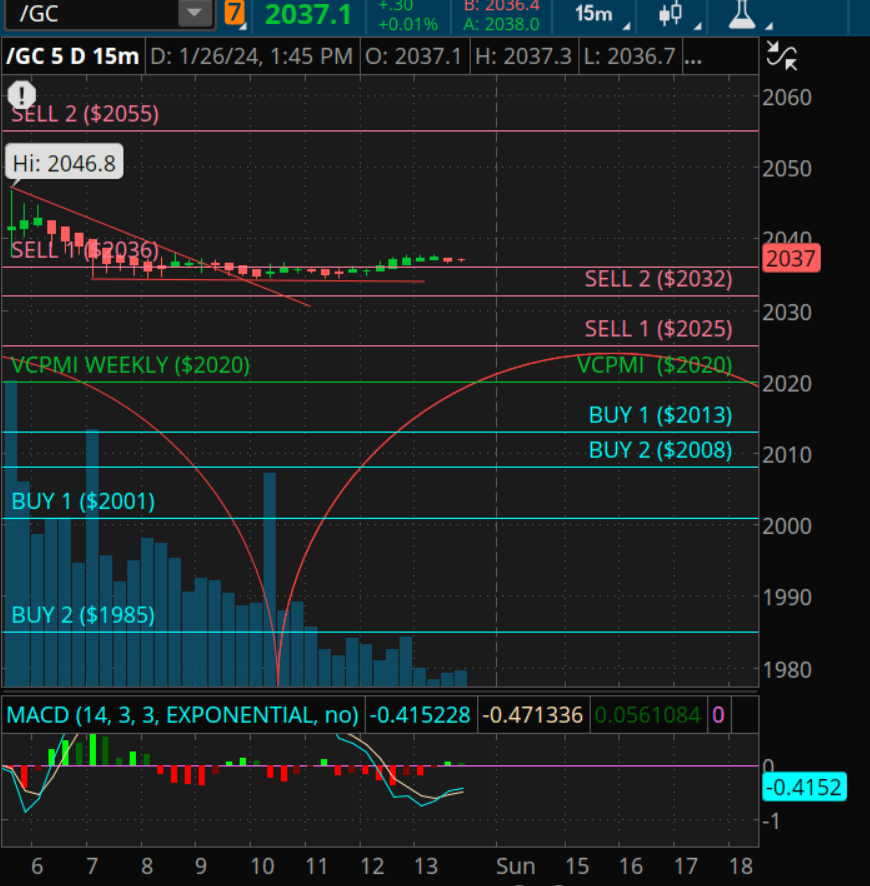chaofann/iStock via Getty Images
Fundamentals:
The gold market has been searching for direction in the early part of the year, with prices hovering around the $2010 to $2020 per ounce range. This uncertainty is linked to investors’ speculations about when the Federal Reserve will start reducing interest rates in 2024. Initially, there was a slide in gold prices due to a strengthening US Dollar, but the possibility of a rate cut in March appears to be diminishing as January progresses.
The expectation of earlier rate cuts had been dampened by strong economic reports from the US, indicating that the Federal Reserve might not feel pressured to ease financial conditions if the risk of a recession decreases. A significant event that affected the gold market during the week was the release of S&P Global’s PMI assessment on the US manufacturing sector, which exceeded expectations, signaling an expansion in the industrial sector. This caused a sharp drop in gold prices, briefly dipping below $2015, before stabilizing.
Despite the strong economic data, the US Dollar didn’t strengthen correspondingly, and this contributed to gold maintaining some support among investors. A similar scenario occurred later in the week when the US GDP growth for the final quarter of 2023 came in at +3.3% QoQ, higher than some estimates. Gold prices held steady, even amid discussions about the potential hawkish signals this could send to the Federal Reserve.
The week ended with a focus on the Fed’s PCE Price Index on inflation and a stronger level of consumer spending reported for December 2023. Gold weakened slightly but still found support around $2015 per ounce.
Looking ahead, the coming week will be crucial for gold’s performance as it will coincide with the first FOMC meeting of 2024, the ISM’s assessment of the manufacturing sector, and the January Jobs Report. Despite the recent fluctuations, there seems to be a positive tone for gold’s prospects in the first quarter of the year. Traders are anticipating further developments in the market and keeping a close watch on economic data and Fed decisions.
In conclusion, the gold market has experienced volatility driven by economic data and Fed rate cut expectations, but it continues to show resilience and support from buyers. The upcoming week will provide further clarity on the market’s direction.
Let’s take a look at next week’s standard deviation report and see what short term trading opportunities we can identify.
GOLD: Weekly Standard Deviation Report
Jan. 27, 2024 3:22 PM ET
Summary
- Gold futures contract closed at 2017, confirming a bearish weekly trend momentum.
- Market closed below VC Weekly Price Momentum Indicator at 2020, indicating bearish price momentum.
- Traders advised to take profits at 2002-1974 price levels and consider going long on a weekly reversal stop.
gold weekly (TOS)
-
Weekly Trend Momentum: The gold futures contract closed at 2017, and it’s mentioned that a close below the 9-day Simple Moving Average (SMA) at 2048 confirms a bearish weekly trend momentum. Conversely, a close above the 9 SMA would change the trend from bearish to neutral.
-
Weekly Price Momentum: The market closed below the VC Weekly Price Momentum Indicator at 2020, confirming a bearish price momentum. A close above this indicator would change the short-term trend from bearish to neutral.
-
Weekly Price Indicator: The advice here seems to be for traders to take profits if they are short on corrections at the 2002–1974 price levels. Additionally, they are advised to go long on a weekly reversal stop. If they are long, they should use the 1974 level as a Monthly Stop Close Only and Good Till Cancelled order. The suggestion is to consider taking profits when gold reaches the 2090-levels during the month.
-
Cycle: There’s a mention of a cycle with a due date of 1.30.24. This date may be significant in your trading strategy.
-
Strategy: If you are short, you are advised to take profits when gold reaches the 2001-1974 level.
- Performance:
It’s important to note that trading and investing in financial markets carry risks, and decisions should be made with careful consideration of your risk tolerance and financial goals. Additionally, market conditions can change rapidly, so it’s important to stay updated with the latest information and adapt your strategy accordingly. It’s always a good idea to consult with a financial advisor or do thorough research before making any trading decisions.
Disclaimer: The information in the Market Commentaries was obtained from sources believed to be reliable, but we do not guarantee its accuracy. Neither the information nor any opinion expressed herein constitutes a solicitation of the purchase or sale of any futures or options contracts. It is for educational purposes only.



